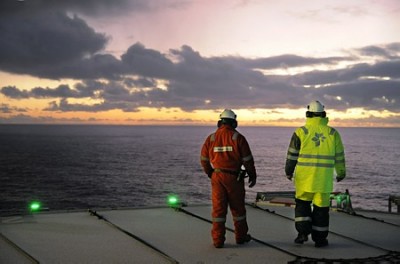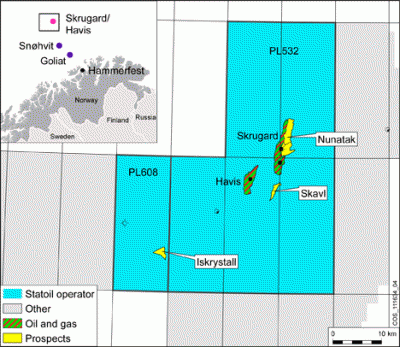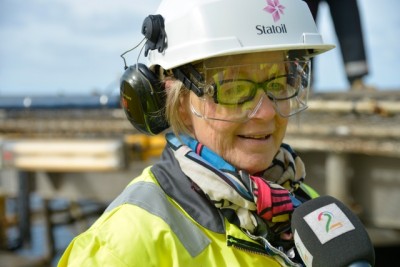Just as the Norwegian government is being urged to slow down the pace of offshore oil and gas production comes news that state-controlled Statoil has made another discovery in the Barents Sea. Statoil, already in a cost-cutting mode, will likely be inclined to develop this discovery despite curtailments elsewhere.

Gro G Haatvedt, Statoil’s exploration director on the Norwegian continental shelf, said the company has been putting a lot of effort into finding additional resources around the Johan Castberg (formerly Skrugard) field northwest of Hammerfest, to make the field’s development “more robust.” That means Statoil needs to be able to tap into extras reserves to make Johan Castberg profitable.
The new discovery, estimated to yield between 20 million and 50 million barrels, was found in the so-called Skavl prospect, near Castberg in the Barents Sea and thus making Castberg’s development far more worthwhile. “We are very glad to see that the (exploration) efforts are now paying off,” Haatvedt said.
Statoil also plans to continue exploration for even more oil resources around Castberg. After finishing the current drilling project at Skavl, Statoil’s drilling rig will move 16 kilometers to the north to drill at Kramsnø. More exploration around Castberg will continue into 2014.

“We will now evaluate whether the discovery can be taken in as part of the development of the Johan Castberg field,” Erik Strand Tellefsen, Statoil’s director for development in Northern Norway, told news bureau NTB. “At the same time we’ll continue work on the resource base and field development. Changes in the tax framework are one of the components that’s made the project more demanding.”
While oil and gas discovery is generally seen as good news, some top politicians have been advocating a slowdown in oil and gas activity in general. Trine Skei Grande of the Liberal Party, one of the government’s support parties in opposition, and Heiki Holmås of the Socialist Left Party are both calling on Norway’s new conservative government coalition to “slow down the tempo” of oil operations both for the sake of the climate (especially in Arctic areas) but also to help wean Norway away from too much economic dependence on oil. As some offshore fields are due to run dry, it’s time, they feel, to develop other economic areas to carry Norway into the next century.

Major changes in the gas market are also changing the outlook for Statoil, as shale developments not least in the US are driving gas prices down. Lower prices also raise questions about the profitability of gas field development in challenging Arctic waters, which is hugely expensive at a time when European markets have seen a resurgence of coal used for energy production. Even the increasing popularity of electric cars and alternative energy are raising questions about whether oil and gas will still be as valuable in the years to come, as they have been to date.
Statoil has thus been embarking on a major cost-cutting drive, given lower returns despite a doubling of oil prices since 2005. Costs have continued to rise and Statoil’s finance director, Torgrim Reitan, says the situation is serious.
Oil industry facing ‘huge challenges’
“The oil industry is changing quickly and faces huge challenges,” he told newspaper Aftenposten recently. “The macroeconomic picture is unclear. We’re used to living with uncertainty and big swings in oil prices, but the decline in yields has made us all much more vulnerable than earlier.”
Statoil’s cost-cutting, which includes outsourcing and staff cuts, is not popular within the company or with its labour organizations. It’s even been blamed on problems at its Njord platform off Norway, which has been taken out of production, reportedly because cost-cutting during its construction left it with maintenance issues after just 16 years of operation.
Investor and industrialist Jens Ulltveit-Moe called Statoil “yesterday’s company” late last week, because investors aren’t interested in it any longer. Renewable energy projects are more attractive, claims Ulltveit-Moe, who also has been a proponent of making Norway less dependent on oil to fuel its economy.
New discovery ‘disappointing’
Newspaper Upstream reported recently that Statoil is also set to abandon an ambitious plan to power its giant Johan Sverdrup field in the North Sea with a subsea electrical cable from shore, to cut costs. That’s also likely to upset environmentalists and many Members of Parliament.
Statoil officials therefore seemed relieved for some good news out of the Barents on Monday, where two of four wells contained gas around Johan Castberg. One analyst, though, called the discoveries “disappointing.”
Website dn.no reported late Monday that Lars-Henrik Røren of SEB was calling the oil and gas volumes “very small.” He also claimed the largest reservoir was of poor quality, and the second had less oil than expected.
newsinenglish.no/Nina Berglund

